
Ehdrigohr: The Roleplaying Game is an indie role-playing game released by the indie publisher Council of Fools in 2012 in which players are members of nine indigenous tribes coexisting with spirits and other forces around them.

Ehdrigohr: The Roleplaying Game is an indie role-playing game released by the indie publisher Council of Fools in 2012 in which players are members of nine indigenous tribes coexisting with spirits and other forces around them.
Ehdrigohr is a fantasy role-playing game where each of the nine tribes of the game represent a real-world tribal culture. Most of them are Native American such as Lakota, Cheyenne, and Aztec, but some cultures outside of North America such as Bedouin and Celt are also present. [1] A great war has just ended in a stalemate, and powerful magics are still present, as well as terrible creatures of the night. [1] The game is an indigenous world without colonizers, where each tribe must find a path in the world. [1]
Although two character classes, the Solitary and the Thief, resemble the classic Dungeons & Dragons classes of solitary fighter and thief, others in this game are designed to serve their communities in various ways. The Dove Society protects the community from undead, the Society of Crows protects the community from the forces of darkness, the Jays attempt to unite the tribes; other professions like guards and traders can also be played as members that serve the community. [1] An important objective is for the tribe to survive the long, dark winters of this world. [2]
The game uses the FATE 3.0 rule system.
Allen Turner, who is Black, Lakota and Irish, designed Ehdrigohr as a "survival horror game", [2] and it was published in 2012 by indie publisher Council of Fools as a 350-page book with cover art by Valerie Xanos, and interior art by Jordan Cuffie, Ruth Harvey-Turner, John Wesley O'Seadna, Eric Ridgeway, Greg Taylor, and Anna Todaro, and cartography by Robert Altbauer. [3]
Writing for Boing Boing, Daniel Starkey commented, "Designed over the course of several years by black, American Indian game designer Allen Turner, Ehdrigohr filters Dungeons and Dragons-style roleplaying experiences through a distinctly Native cultural lens rather than a European one." Starkey called it "an incredibly broad and flexible game, one where you can create almost any character imaginable, or even choose to play without any combat at all. You won't need a vast array of multifaceted dice in order to play, and where Dungeons and Dragons has very exact and specific rules about how far you can move each turn or how many items your character can carry, Ehdrigohr lets you do whatever seems reasonable." Starkey concluded, "Ehdrigohr is already more to me than just a fun game; it's a chance to use a game in the same way that storytellers used the fables that inspired it—to teach, to connect, and to love." [4]
Emilee Guevara, writing for The Link, noted, "The game requires introspection and improvisation from participants, where players are required to create new identities and make decisions on how to deal with conflict ... Consistent with many Indigenous traditions, an acute awareness of one’s narrative is vital for surviving the game." Guevara concluded, "By exemplifying the power of the imagination and the potential of innovative game designs, Ehdrigohr makes the impossibility of decolonized realities possible." [2]
In his 2023 book Monsters, Aliens, and Holes in the Ground, RPG historian Stu Horvath compared the game to others that have used indigenous culture such as Deadlands and Shadowrun , especially their use of the Ghost Dance, saying, "In both those games, the Ghost Dance is a plot device, deployed to cataclysmically change the colonizers and land-stealers' way of life by reintroducing magic to the world ... These sorts of portrayals of indigenous cultures seem like ill-informed caricatures when they're lined up with the tribal groups seeking harmony and strong community in Ehdrigohr." Horvath concluded, "It's a game of hope." [1]
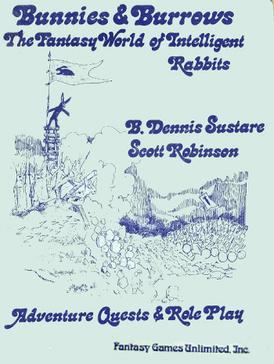
Bunnies & Burrows (B&B) is a role-playing game (RPG) inspired by the 1972 novel Watership Down. Published by Fantasy Games Unlimited in 1976, the game is centered on intelligent rabbits. It introduced several innovations to role-playing game design, being the first game to encourage players to have non-humanoid roles, and the first to have detailed martial arts and skill systems. Fantasy Games Unlimited published a similar second edition in 1982. Frog God Games published a revised third edition in 2019 from the original authors. The game was also modified and published by Steve Jackson Games as an official GURPS supplement in 1992.

RuneQuest is a fantasy tabletop role-playing game originally designed by Steve Perrin, Ray Turney, Steve Henderson, and Warren James, and set in Greg Stafford's mythical world of Glorantha. It was first published in 1978 by The Chaosium. Beginning in 1984, publication passed between a number of companies, including Avalon Hill, Mongoose Publishing, and The Design Mechanism, before finally returning to Chaosium in 2016. RuneQuest is notable for its system, designed around percentile dice and an early implementation of skill rules, which became the basis for numerous other games. There have been several editions of the game.
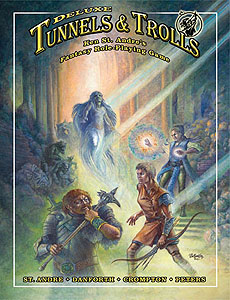
Tunnels & Trolls is a fantasy role-playing game designed by Ken St. Andre and first published in 1975 by Flying Buffalo. The second modern role-playing game published, it was written by Ken St. Andre to be a more accessible alternative to Dungeons & Dragons and is suitable for solitaire, group, and play-by-mail gameplay.

Castle Falkenstein is a steampunk-themed fantasy role-playing game (RPG) designed by Mike Pondsmith and originally published by R. Talsorian Games in 1994. The game is named for a legendary unbuilt castle in the Bavarian Alps. Players play the roles of gallant adventurers who take on quests of intrigue and derring-do in the spirit of Victorian adventures such as The Prisoner of Zenda.
A Splatbook is a sourcebook for a particular role-playing game that is not needed for play, but is devoted to a particular facet, character class, or fictional faction, providing additional background details and rules options. For example, a "swords and sorcery" fantasy game might offer splatbooks for each of the races in the setting: humans, dwarves, elves, and others.
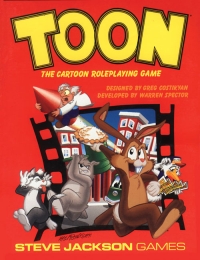
Toon is a comedy tabletop role-playing game in which the players take the roles of cartoon characters. It is subtitled The Cartoon Roleplaying Game. Toon was designed by Greg Costikyan and developed by Warren Spector, and first published in 1984 by Steve Jackson Games.

Empire of the Petal Throne is a fantasy role-playing game designed by M. A. R. Barker, based on his Tékumel fictional universe. It was self-published in 1974, then published by TSR, Inc. in 1975. It was one of the first tabletop role-playing games, along with Dungeons & Dragons, and was the first published RPG game setting. Over the subsequent thirty years, several new games were published based on the Tékumel setting; however, to date, none have met with commercial success. While published as fantasy, the game is sometimes classified as science fantasy or, debatably, as science fiction.
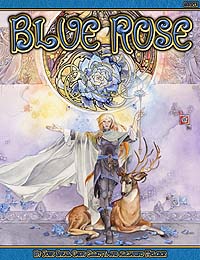
Blue Rose is a fantasy role-playing game published by Green Ronin Publishing in 2005. The game is in the romantic fantasy genre, inspired by fantasy fiction such as that of Mercedes Lackey and Diane Duane as opposed to Conan the Barbarian–style swords and sorcery, and uses a derivative of the D20 system called True20. Blue Rose is notable for being the first role-playing game to explicitly accept characters of all genders and sexual orientations as well as romantic relationships between any two or more characters who are adults.

Dogs in the Vineyard is an independently published role-playing game published by Lumpley Games in 2004 that is loosely based on the history of the Mormons.
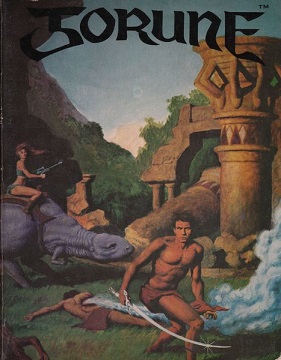
Skyrealms of Jorune is a science-fantasy role-playing game that was first published in 1984 through SkyRealms Publishing. The game is set on the fictional alien planet of Jorune above which float levitating islands. The second edition was published in 1986 as a boxed set, and a third edition was published by Chessex in 1992. The computer game Alien Logic: A Skyrealms of Jorune Adventure was published in 1994. The various editions received positive reviews in game periodicals including Casus Belli, White Dwarf, White Wolf, Different Worlds, Dragon, Polyhedron, The Games Machine, and Challenge.

Dungeon Crawl Classics Role Playing Game is a role-playing game published by Goodman Games using the Open Game License (OGL) and System Reference Document (SRD) version 3.5 to provide legal compatibility with the revised third edition of Dungeons & Dragons.

Conan Unchained! is a 1984 adventure module for the Dungeons & Dragons roleplaying game that centers on an adventure of the fictional hero Conan the Barbarian and his companions.
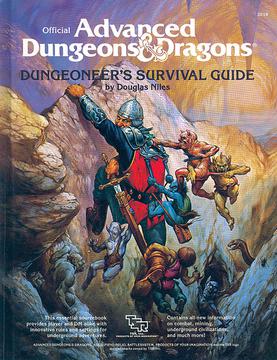
Dungeoneer's Survival Guide is a supplement to the Dungeons & Dragons fantasy role-playing game. The book was written by Douglas Niles, and published by TSR, Inc. in 1986.

A tabletop role-playing game, also known as a pen-and-paper role-playing game, is a kind of role-playing game (RPG) in which the participants describe their characters' actions through speech and sometimes movements. Participants determine the actions of their characters based on their characterization, and the actions succeed or fail according to a set formal system of rules and guidelines, usually involving randomization. Within the rules, players have the freedom to improvise, and their choices shape the direction and outcome of the game.

Nightwatch in the Living City is a collection of adventures published by the RPGA in 1991 for their Living City shared campaign world set in the Forgotten Realms using the second edition of the fantasy role-playing game Advanced Dungeons & Dragons.

The Old School Renaissance, Old School Revival, or OSR, is a play style movement in tabletop role-playing games which draws inspiration from the earliest days of tabletop RPGs in the 1970s, especially Dungeons & Dragons. It consists of a loose network or community of gamers and game designers who share an interest in a certain style of play and set of game design principles.

The Bullwinkle and Rocky Role-Playing Party Game is a role-playing game published by TSR in 1988. It is based on characters and settings from The Rocky and Bullwinkle Show.
Shannon Appelcline is a historian of tabletop role-playing games and a game designer. Two different editions of his book Designers & Dragons have won ENNIE Awards.

Cults of Prax is a supplement published by Chaosium in 1979 for the fantasy role-playing game RuneQuest that describes the various religions that are central to the game. It was republished in 2016 in PDF format as part of Chaosium's RuneQuest: Classic Edition Kickstarter.

Microscope is an indie role-playing game in which players create a fictional historical timeline, then zoom in to role-play specific events on that timeline. It was designed by Ben Robbins and released by Lame Mage Productions in 2011.